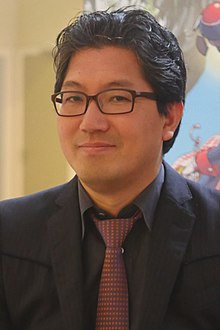Portal:Video games
The Video Games Portal

A video game, also known as a computer game or just a game, is an electronic game that involves interaction with a user interface or input device (such as a joystick, controller, keyboard, or motion sensing device) to generate visual feedback from a display device, most commonly shown in a video format on a television set, computer monitor, flat-panel display or touchscreen on handheld devices, or a virtual reality headset. Most modern video games are audiovisual, with audio complement delivered through speakers or headphones, and sometimes also with other types of sensory feedback (e.g., haptic technology that provides tactile sensations). Some video games also allow microphone and webcam inputs for in-game chatting and livestreaming.
Video games are typically categorized according to their hardware platform, which traditionally includes arcade video games, console games, and computer (PC) games; the latter also encompasses LAN games, online games, and browser games. More recently, the video game industry has expanded onto mobile gaming through mobile devices (such as smartphones and tablet computers), virtual and augmented reality systems, and remote cloud gaming. Video games are also classified into a wide range of genres based on their style of gameplay and target audience. (Full article...)
Featured articles –
Square Pictures rendered the film using some of the most advanced processing capabilities available at the time. A render farm of 960 workstations was tasked with rendering each of the film's 141,964 frames. It took a staff of 200 about four years to complete The Spirits Within. Square intended to make the character of Aki Ross into the world's first photorealistic computer-animated actress, with plans for appearances in multiple films in different roles.
The Spirits Within premiered in Los Angeles on July 2, 2001, and was theatrically released in the United States on July 11. It received mixed reviews, but was widely praised for its characters' realism. Due to rising costs, the film greatly exceeded its original budget toward the end of production, reaching a final cost of $137 million (equivalent to $214 million in 2023); it grossed only $85.1 million at the box office. The film has been called a box-office bomb and is blamed for the demise of Square Pictures. (Full article...)
Independent video game developer Nicalis worked with Amaya to port the game to WiiWare and DSiWare in 2010. An enhanced version, Cave Story+, was released for Steam in November 2011, and the original game was released for the Nintendo 3DS in October 2012 with added content. A 3D remake of the game, titled Cave Story 3D, was developed by Nicalis and published by NIS America for the Nintendo 3DS in November 2011. A port of Cave Story+ for the Nintendo Switch was released in June 2017.
Cave Story revolves around Quote, a robot who wakes up suffering from amnesia and explores in diverse cavernous areas in order to uncover his backstory and escape from the cave. The character gains access to new areas as he powers up his weapons by collecting triangular experience crystals and solves various platforming puzzles. Quote speaks to non-player characters scattered around the game world in order to learn more about the world and its inhabitants. (Full article...)
Cyan began developing Uru shortly after completing Riven in 1997, leaving future Myst sequels to be produced by third-party developers. Uru required five years and $12 million to complete. Uru was initially conceived as a multiplayer game; the single-player portion was released, but the multiplayer component, Uru Live, was delayed, released, and then eventually canceled. The online video game service GameTap re-released the multiplayer portion of Uru as Myst Online: Uru Live in February 2007, but the service was canceled again the following year due to a lack of subscribers. GameTap passed the rights to Uru Live back to Cyan, who re-launched the game for free in 2010.
Uru was not as well received as previous Myst titles. Critics admired the visuals and new features of the game but criticized the lack of multiplayer in the retail version and clunky controls. Compared to previous games in the series, which had sold millions of units, Uru's sales were considered disappointing. The game was a critical and commercial disappointment for Cyan, causing the company financial troubles; nevertheless, it has attracted a cult following. (Full article...)

Oxenfree is a graphic adventure game developed and published by Night School Studio. It was released for OS X, Windows, and Xbox One in January 2016. PlayStation 4 and Linux versions were released later in 2016, followed by iOS, Android, and Nintendo Switch versions in 2017. In Oxenfree, players assume the role of the teenage girl Alex on a weekend trip to a local island. After seemingly supernatural events occur, Alex and her friends must unravel the secrets of the island.
The game is Night School Studio's debut. Influenced by classic teen films and coming-of-age shows, the developers wanted to create a story-driven game without cutscenes, allowing players to roam the environment freely. Oxenfree's visual presentation marries dark, organic, and analog elements with bright, geometric, and digital ones. Musician scntfc composed the game's soundtrack, which features digital music production techniques alongside the use of vintage analog tape recorders and receivers.
Oxenfree's release was accompanied by development documentaries, an alternate reality game, and a collector's edition, and was met with generally positive reviews, with critics praising the presentation and characters, although some of them were left wanting more. The game was nominated for multiple awards including "Best Narrative" at The Game Awards 2016 and "Outstanding Achievement in Story" at the 20th Annual D.I.C.E. Awards. A sequel, Oxenfree II: Lost Signals, was released on July 12, 2023. A television series adaptation is also in development. (Full article...)
Sega felt an RPG was critical to compete against the PlayStation and Final Fantasy. Development began in early 1995 alongside Panzer Dragoon II Zwei (1996). The project was arduous and repeatedly delayed; incorporating the Panzer Dragoon shooting elements with full 3D computer graphics and voice acting, both unusual features in RPGs at the time, pushed the Saturn to its technical limits and strained team relations. Two staff members died during development, which the director, Yukio Futatsugi, attributed to stressful working conditions.
Panzer Dragoon Saga is one of the most acclaimed Saturn games and is listed among the greatest video games, earning praise for its story, graphics, and combat. Sales were low, and only a few thousand copies were published in the west, where Sega had shifted focus to its Dreamcast console. (Full article...)
Rare was a prominent second-party developer for Nintendo in the 1990s, and their Killer Instinct series was produced as an exclusive partnership in response to the popularity of Mortal Kombat. Following the success of the 1995 Killer Instinct port for the Super Nintendo Entertainment System, Rare began a sequel for the same platform but transitioned development to its successor, the Nintendo 64, upon its unveiling. Gold was scheduled as a launch title for the new console but was delayed until its North American release in November 1996. It was released in other regions in May 1997. Gold was later included in Rare's 2015 Xbox One retrospective compilation, Rare Replay.
Reviewers preferred the Nintendo 64 port over the arcade release, and appreciated its audiovisual enhancements, but felt that its graphical upgrades and memorization-based combo gameplay were insufficient when compared to fighting games like Tekken 2 and Virtua Fighter 2. Critics recommended Gold primarily for fans of the series and genre, but IGN reported that even fans were upset by changes in the combo system and the absence of several well-liked characters. Gold ultimately did not replicate the success of its Super NES predecessor, and the series remained dormant through its 2002 acquisition by Microsoft until its 2013 reboot. (Full article...)
After the Sequel was inspired by Sonic Heroes and other games both inside and outside the Sonic series, and it was developed with Sonic Worlds, an engine based in Multimedia Fusion 2 that reduces the amount of computer programming involved in game creation. It was released as a free download for Windows personal computers on June 15, 2013. The game was very well received by video game journalists, who lauded its preservation of retro Sonic gameplay and its 1990s-style soundtrack. The trilogy of Before the Sequel, After the Sequel, and their successor Sonic Chrono Adventure performed unusually well for fangames, having been downloaded 120,000 times by March 2014. (Full article...)
The game is based on the fictional extreme sport Blitz, a futuristic full-contact hybrid of hockey and basketball played with a flying disc. Two teams of four players attempt to move the disc through their opponent's goal, and teams can either win on points or by knocking out their opposing team. There are 150 individual characters across 18 thematic teams. The single-player campaign's plot is set in the 23rd century, when Blitz is a popular, televised sport and the teams battle to scale the ranks and win the championship. Players earn credits from their goals scored, opponent knockouts, and crowd-pleasing to be spent on player upgrades, bets, and new teammates. The game also supports split-screen and System Link multiplayer for up to eight players across up to eight Xbox consoles.
Deathrow received largely favorable reviews. Reviewers praised the game's fast-paced action, and surround sound, but complained of its high difficulty curve, generic soundtrack, and lack of online multiplayer. Some critics felt the game's use of profanity was excessive, while others thought it was a highlight. Reviewers considered the game's concept and mechanics similar to other series, specifically Speedball. IGN and TeamXbox both named Deathrow an Editor's Choice. The game won the TeamXbox 2002 Breakthrough Game of the Year award and the IGN 2002 Best Game Nobody Played. IGN later reported that a sequel would be unlikely due to the original's low revenue. Southend dissolved in 2013. (Full article...)
Did you know... -
- ... that the leak of the upcoming Grand Theft Auto game was described as one of the biggest leaks in video game history?
- ... that the web-based video game Moderator Mayhem was based on a card game meant to demonstrate the difficulties of content moderation?
- ... that the case Lewis Galoob Toys, Inc. v. Nintendo of America, Inc. was considered essential to the future of video game modding in the United States in 1992?
- ... that classified documents of the United States were partially leaked onto a Discord server for the video game Minecraft?
- ... that a cheat code for the 2003 video game Hulk is hidden in a scene of the film it is based on?
- ... that deceased YouTuber Technoblade beat the video game Minecraft in hardcore mode using a racing-wheel controller?
- ... that LittleBigPlanet, a video game that allows the player to create levels, coincided with the rise of user-generated content?
- ... that Paul Dini was a writer for both the animated television series Batman: The Animated Series and the video game series Batman: Arkham?
- ... that the success of Kingdom Rush prompted plans to grow the video game industry of Uruguay?
- ... that the contrabass trombone has experienced a revival in film music and video game soundtracks?
- ... that the illustrations in the 1992 video game Tetris Classic are based on scenes from Alexander Pushkin's poem Ruslan and Ludmila?
- ... that the album series Jingle Cats spawned Jingle Dogs, Jingle Babies, and a Japanese video game in which "the object is to breed and care for cats, which begin to sing when they're done copulating"?
Selected biography –
Selected image -

Recent video game-related events
- August 15, 2024 –
- American video game magazine Game Informer discontinues publication after 33 years. The magazine's website is also shut down. (BBC News)
- May 24, 2024 – Uvalde school shooting
- Families in Uvalde, Texas, U.S., file a lawsuit against Daniel Defense and Activision Blizzard for creating the DDM4 V7 gun and promoting the weapon through the game Call of Duty, respectively. They also sue Meta Platforms for owning Instagram, which was used by the gunman. (AP)
- April 16, 2024 – 2023–2024 video game industry layoffs
- American video game company Take-Two Interactive lays off 5% of its workforce. (Reuters)
Topics
Categories
Things you can do
In other Wikimedia projects
The following Wikimedia Foundation sister projects provide more on this subject:
-
Commons
Free media repository -
Wikibooks
Free textbooks and manuals -
Wikidata
Free knowledge base -
Wikinews
Free-content news -
Wikiquote
Collection of quotations -
Wikisource
Free-content library -
Wikiversity
Free learning tools -
Wiktionary
Dictionary and thesaurus














































